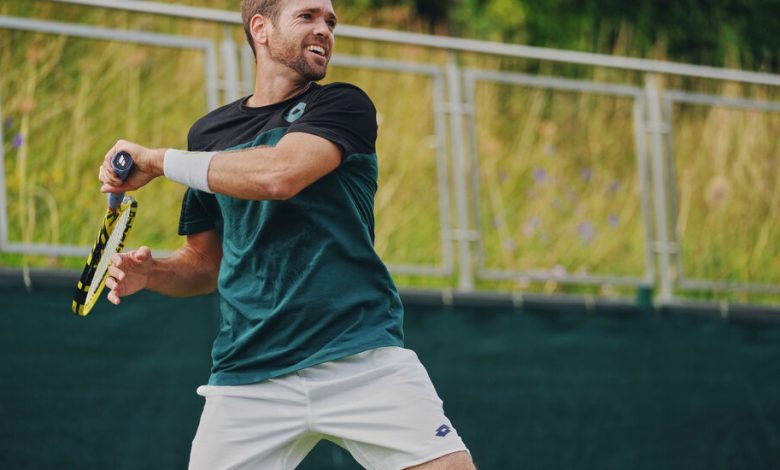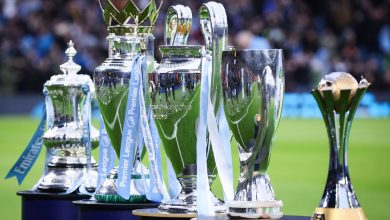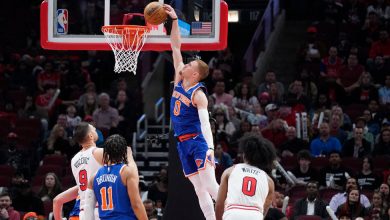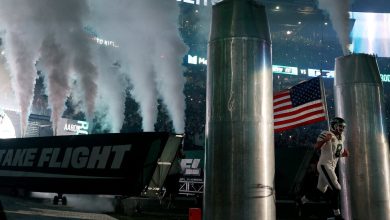He Nearly Gave Up on Tennis to Sell Insurance. Then a Friend Called.

The last time Austin Krajicek stormed through the front door, threw his tennis bag into a closet and announced that he was done with the sport for good, his wife, Misia Kedzierski, thought he might actually be serious.
Krajicek, a big-hitting lefty from Florida who had been a champion as a junior and in college, had spent seven years toiling on the professional tennis tour, breaking into the top 100 in singles a couple times, even winning a couple of matches in Grand Slam tournaments. But as the summer of 2018 approached, the losses piled up and his singles ranking tumbled into the 300s.
He and Kedzierski had been living in a cheap apartment in Chicago that summer, with a mattress on the floor, some old furniture from her parents’ house, a few dishes and their dog. She never questioned his tennis pursuits, but she was also covering most of their expenses, as Krajicek’s tennis career was costing him more than he was bringing in.
“It’s like that awkward time where you don’t want to talk about money necessarily,” Kedzierski, a data analyst for the restaurant industry, recalled recently. “But then you get to a point where you’re like, ‘Well, if we can’t pay rent, then should we keep doing what we’re doing right now?’”
Krajicek didn’t think so.
“It’s a brutal sport, and you have to be a little bit insane to keep going,” he said during a recent interview from his home in Allen, Texas, north of Dallas.
Tennis seemed to be telling Krajicek to give up on the dream of competing for the biggest titles in the sport that had largely defined his life since he was 6 years old. At 28 he was no longer a kid, and he was a few credits short of finishing his degree in psychology from Texas A&M. He was getting his license to sell insurance. He was ready for Plan B.
Then he got a call from a buddy from his college tennis days. Did he want to travel to England to play doubles in some minor league tournaments?
Krajicek got his tennis bag out of the closet.
One last shot.
Playing for His Next Meal
Krajicek, who is a distant relative of the 1996 Wimbledon men’s singles champion, Richard Krajicek, began his tennis journey when he was 5, asking his father, a formercollege basketball player who had taken up tennis at a club near Tampa, if he could tag along. Soon he was training several days a week with the club professional, and soon after that, the club pro told Austin’s father he needed to find his son a better coach.
At 14, Krajicek enrolled in the IMG Academy in Bradenton, where Nick Bollettieri famously churned out future champions under the often stifling Florida sun. At 18, Krajicek won the U.S. national junior championship in Kalamazoo, Mich., and flirted with turning professional. He opted instead to attend Texas A&M, to give his body and his game a few more years to develop. In 2011, he won the N.C.A.A. men’s doubles title.
Then it was time to start playing for his next meal.
The journey to the tennis big leagues has a few stops in grand world capitals like Paris and London, but players can spend far more nights in destinations like Binghamton, N.Y; Aptos, Calif.; Rimouski, Quebec; and Gimcheon, South Korea. There are terrible hotels, a lot of bad meals, and plenty of empty bleachers. Or no bleachers at all.
Krajicek was a newly minted pro playing in a minor tournament in Champaign, Ill., when he met Kedzierski, a senior tennis player at the University of Illinois. A friend of Kedzierski’s had a crush on Krajicek but was too nervous to reach out. Kedzierski got his number and texted him on her friend’s behalf only to learn that Krajicek was interested in Kedzierski.
They had their first dinner two months later in Maui, when they realized they were both there for tennis competitions. Nice guy, she thought.
After graduation, she moved to Los Angeles to work for a stylist in the entertainment business. Krajicek, a master couch surfer who often stayed in the vacation homes of wealthy tennis boosters, was using Los Angeles as a training base. He started staying at Kedzierski’s place, showing up with his tennis bag and a suitcase, training for a week or two, and then heading back out on the road.
Pretty quickly, Kedzierski discerned that Krajicek didn’t actually have a home. She told him he could leave a pair of shoes at her place if he wanted. He said no thanks — he was fine living out of the suitcase.
She went about her career and got a master’s in marketing at Texas A&M.
And he went about his, such as it was. In 2018, seven years into his pro career, Krajicek was winning just 38 percent of his singles matches. That was when Kedzierski began to see her boyfriend toss his tennis bag into the closet and swear off the sport a little more often.
Tennis Wasn’t the Problem
For all but the best tennis players, the fleeting nature of top form is often a mystery.
“Anyone in the top 250 can make a good week,” Daniil Medvedev of Russia, one of the game’s best players and its top player-pundit, has said, over and over. No one disagrees with him.
Krajicek found his form once more when he headed to England with Jeevan Nedunchezhiyan, whom he had played tennis with at Texas A&M. Maybe it was the comfort of playing with an old friend. Maybe it was because he had reached the point where he was ready to let it all go.
Whatever the reason, he and Nedunchezhiyan quickly made the final of a tournament in Nottingham. The next week, they won a tournament in Ilkley in northern England. The week after that, they won two matches and qualified for the main draw at Wimbledon, where they lost in the first round in a third-set tiebreaker.
Krajicek flew back to Chicago to the cheap apartment with the mattress on the floor. The next week, there was a small pro tournament just up the road in Winetka, Ill., a 20-minute drive. He and Nedunchezhiyan figured, why not enter? They won it, sharing $4,650 in prize money.
This was beginning to get interesting.
In addition to his size and power, Krajicek had something that most doubles players do not. He is left-handed, which can instantly turn a quality team into a dangerous one because opponents have to adjust to different angles and spins of the ball. The usual weak spots for teams with two right-handed players aren’t there.
Tennys Sandgren, another old friend who had climbed into the top 70 in singles, asked Krajicek to be his partner at the U.S. Open. They reached the quarterfinals. Rajeev Ram, who was on his way to becoming one of the top doubles players in the world, asked him to play an ATP event in Moscow. They won.
That was when Krajicek concluded tennis wasn’t the problem. Singles was.
“I was over it,” he said.
Doubles became the only mountain he would attempt to climb.
A Turning Point
Krajicek’s productive summer and fall had made had tennis financially sustainable. Now he was qualifying for ATP Tour events, where the prize money was significantly higher than on the lower-level tour. By 2021, he had made the U.S. Olympic team, but it was clear that he still needed to improve to make it into the top echelon of the pro game.
He and Kedzierski had moved to Texas. On a hot spring afternoon, Krajicek landed on a backyard court that belonged to a friend of Phil Farmer, a highly regarded coach. Farmer had worked with top Americans, including John Isner, Sam Querrey and the Bryan brothers, one of the sport’s great doubles duos. A player Farmer was coaching at the time had told Farmer he had to check out his hitting partner.
He obliged. Running Krajicek through a series of drills, he immediately saw a player with a huge serve who could nail targets down the line and crosscourt with both his forehand and his backhand. Krajicek also had soft hands and a stinger of a forehand volley.
“I could really envision where his game was and where it needed to go,” said Farmer, who has been coaching him ever since.
There was room for improvement — he needed to be more aggressive with his returns, and serve to the whole service box, rather than just his favorite spots. His low volleys needed work.
He also needed a permanent partner. Then Ivan Dodig of Croatia, a mainstay of the doubles tour with a chess master’s understanding of the game, was suddenly free.
He and Krajicek began their partnership in Belgrade, Serbia, in April 2022. By early June, they had reached the French Open final. Kedzierski, who had married Krajicek the previous December, caught a last-minute flight to Paris. She was watching courtside as Krajicek and Dodig squandered three championship points and lost in three sets.
“That was not the match to watch,” she said.
The next day, she and Krajicek delayed their return flight for 24 hours and rode rented bicycles all over Paris.
Back at home, their friend Terry Brush had been keeping a bottle of Old Forester Birthday edition bourbon ready for when Krajicek won his first Grand Slam. He and Farmer, both bourbon lovers, had signed the label, pledging to open it only when they got that victory.
Catching up at home after Paris, Brush asked Krajicek if he wanted to open it. They had come so close.
Not a chance, Krajicek told him.
In a Good Routine
A year later, Krajicek and Dodig were back in Paris, making their way through the French Open draw, but barely. Three of their first four matches went to deciding third sets as they vanquished a couple of Argentines, a Swiss and a Chilean, a Portuguese and a Brazilian, a pair of Germans, and a Spaniard and another Argentine.
From 5,000 miles away, Kedzierski could tell that with each win, Krajicek’s routine was becoming more precise.
He was eating the same meal (Chipotle delivered to his room) at the same time each day (around 6 p.m. so he could finish eating for the day by 7, which helped him get a good night’s rest). Then he watched videos of his opponents’ matches and went to sleep. Even his text messages to her came at the same time each day, including his check-ins about their two golden doodles, Tucker and Moose.
When Krajicek made it to the finals, he asked her if she was coming to Paris. Not doing it, she told him.
“He was in such a good routine,” Kedzierski said. “There was no way I was going to mess that up.”
The final matched Krajicek and Dodig against Sander Gillé and Joran Vliegen of Belgium. Krajicek and Dodig seized control at the start and never gave it up. Watching from home with a few friends, Kedzierski saw Krajicek’s last blistering forehand clinch the title and, for the next week, the No. 1 ranking. She Facetimed him as soon as the ball landed so that when he looked at his phone, he would see she had called. Fifteen minutes later, from a tunnel under the stadium, he called her back.
She told him how proud she was of him. He reminded her of all the times he had wistfully said he was going to get to the top.
They next day, Krajicek crammed into an economy seat for the flight home to Dallas, even though he had to return to Europe five days later for the grass season and Wimbledon. The emergency exit door was sticking out in front of his seat, forcing him to angle his legs for the better part of 10 hours, leaving his frame a little cockeyed and sore by touchdown.
Kedzierski was waiting for him. So was that bottle of bourbon.




